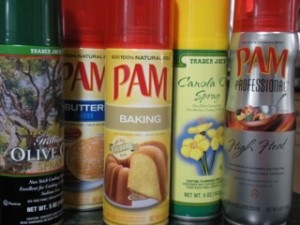Are All Cooking Sprays Created Equal?
I’m staring at five different kinds of cooking spray: Butter flavor, Olive Oil, Canola Oil, Baking, and Professional for high heat cooking. All say they are for non-stick cooking or baking. Some say they are for fat-free cooking and baking.
The nutrition facts for all five say that the serving size is about 1/3 of a second, the equivalent of 0.25 grams. The ingredient labels all list an oil (canola, olive, soybean, or vegetable) as their first ingredient. All have an emulsifier, usually soy lecithin, and a propellant. Some have other flavorings and the baking spray has wheat flour.
Nutrition stats for cooking sprays:
Listed calorie count for a serving (a 1/3 second spray): 0
Total Fat: 0
Time for a Reality Check
Okay. So how can something with oil as the main listed ingredient have zero calories and zero fat? In the US, any product that has less than 5 grams of fat per serving lists the fat content rounded to the nearest 0.5 g. If the product contains less than 0.5 grams of fat per serving, the listed fat content is rounded to 0 grams. If a product contains 0.45 grams of fat per serving and the package has 10 servings, the label would show 0 grams of fat even though the entire package actually contains a total of 4.5 grams of fat.
All of the cooking sprays that I checked call a 1/3 second spray a serving size – that’s the equivalent of .25 grams of fat. Because the serving size, as created by the manufacturers, is under half a gram, the nutrition facts can be listed as 0 grams of fat and 0 calories. Feel duped?
0.25 grams of fat is the equivalent of 2.25 calories (fat has 9 calories per gram), not a huge number. However, how many of you use cooking spray for 1/3 of a second? Can you even coat a small frying pan with a 1/3 second spray?
How Many Calories?
Most of us spritz for at least three to six times as long – many of us for probably longer. A one second spray has about 7 calories, 2 seconds has about 14 and and 1.5 grams of fat. Again, not huge numbers, but 2 seconds is still awfully short. My guess is that a lot of sprays are a bit longer.
SocialDieter Tip:
Remember that nonstick cooking spray is not calorie free. Be careful of drenching your pans and skillets. As you’re spritzing, count the seconds. If the length and number of your spritzes crank up the calorie count, either cut back on the spray or consider using a small amount of oil on a paper towel to coat your pan. Using one teaspoon of olive oil adds 4.5 grams of fat and 40 calories and you will be avoiding the additives and propellant in the cooking spray.


thx for sharing this one!
You’re welcome. Thanks for visiting SocialDieter.